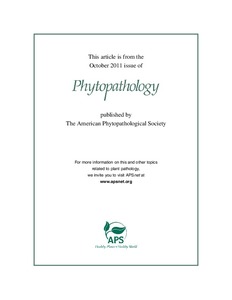| dc.contributor.author | Rwegasira, G.M. |
| dc.contributor.author | Momanyi, G. |
| dc.contributor.author | Rey, M.E.C. |
| dc.contributor.author | Kahwa, G. |
| dc.contributor.author | Legg, J.P. |
| dc.date.accessioned | 2019-12-04T11:10:36Z |
| dc.date.available | 2019-12-04T11:10:36Z |
| dc.date.issued | 2011-11 |
| dc.identifier.citation | Rwegasira, G.M., Momanyi, G., Rey, M.E.C., Kahwa, G. & Legg, J.P. (2011). Widespread occurrence and diversity of Cassava brown streak virus (Potyviridae: Ipomovirus) in Tanzania. Phytopathology, 101(10), 1159-1167. |
| dc.identifier.issn | 0031-949X |
| dc.identifier.uri | https://hdl.handle.net/20.500.12478/2206 |
| dc.description.abstract | Cassava brown streak disease (CBSD) has been a problem in Tanzania since 1936. Existing literature indicated limited distribution of the disease to low altitudes, usually <100 m above sea level, but the current geographical distribution of the disease was not known. Whether a single or many strains for the virus exist in Tanzania had not been reported to date. In this study, CBSD was recorded from sea level to ≈1,800 m above sea level. In total, 2,730 cassava plants were assessed for CBSD leaf symptoms in 91 fields and root symptoms were assessed at 81 sites. A sample was taken from each site for laboratory screening for Cassava brown streak virus (CBSV). CBSD mean foliar and root incidences were 38 and 36%, respectively. Reverse-transcription polymerase chain reaction of a partial 3′-terminal coat protein (CP) region of CBSV indicated the presence of CBSV in 67 of the 91 (73%) samples. Forty-three amplicons were sequenced, and phylogenetic comparisons with nucleotide sequences from GenBank (National Center for Biotechnology Information database) suggested that one major clade of CBSV primarily exists in Tanzania. However, there was nucleotide sequence divergence of up to 19% among the 42 isolates. In all, 42 of the 43 sequences had 80 to 100% nucleotide identity with 6 previously reported CP-CBSV sequences (from Mozambique and Tanzania). In total, 13 of 42 isolates had <80% nucleotide identities with three previously reported Ugandan CBSV sequences. One isolate, FJ687177, shared <78% sequence identity with the other Tanzanian sequences but was closely related (93%) to Ugandan isolates. It is likely that isolate FJ687177 may belong to a less widely distributed recently described species (clade 2) of CBSV, named Ugandan cassava brown streak virus (UCBSV). |
| dc.language.iso | en |
| dc.subject | Cassava |
| dc.subject | Diseases |
| dc.subject | Disease Control |
| dc.title | Widespread occurrence and diversity of cassava brown streak virus (Potyviridae:Ipomovirus) in Tanzania |
| dc.type | Journal Article |
| dc.description.version | Peer Review |
| cg.contributor.affiliation | Sokoine University of Agriculture |
| cg.contributor.affiliation | University of the Witwatersrand |
| cg.contributor.affiliation | International Institute of Tropical Agriculture |
| cg.coverage.region | Africa |
| cg.coverage.region | East Africa |
| cg.coverage.country | Tanzania |
| cg.isijournal | ISI Journal |
| cg.authorship.types | CGIAR and developing country institute |
| cg.iitasubject | Cassava |
| cg.journal | Phytopathology |
| cg.howpublished | Formally Published |
| cg.accessibilitystatus | Limited Access |
| local.dspaceid | 90937 |
| cg.identifier.doi | https://dx.doi.org/10.1094/PHYTO-11-10-0297 |

